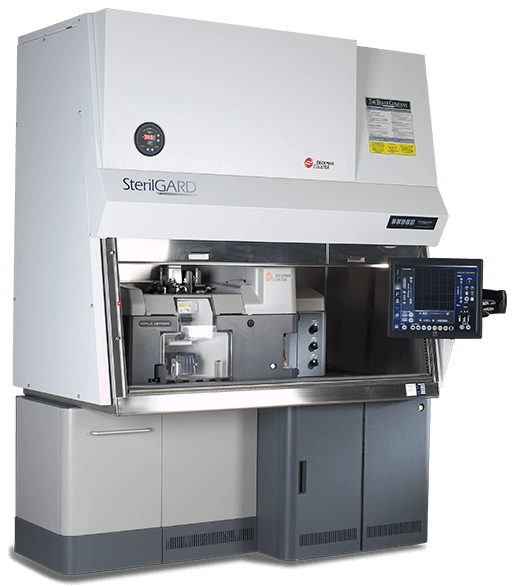- Home
- >
- Instruments
- >
- Beckman Coulter Astrios EQ...

Six-way jet-in-air sorter with 4 lasers (405nm, 488nm, 561nm, 640nm) and 14 fluorescent color capability. It has dual forward scatter PMTs that allow researchers to analyze biological samples ranging in size from 0.2um to 30um. The instrument is capable of simultaneous 1-6 way sorting and is equipped with Cyclone sorting for single cell sorting. Available nozzle sizes are 70um and 100um. It is contained within a Baker SterilGARD Class II biological safety cabinet and can be used for sorting BSL2 samples.
Astrios Configuration
| Excitation | Fluorescence Channels | Fluorochromes |
| 405nm | 448/59 | BV421, DAPI, Pacific Blue |
| 546/20 | Krome Orange, Pac Orange | |
| Side Scatter | ||
| 488nm | 513/26 | FITC, GFP, YFP, AF488 |
| 576/21 | PE, DsRed | |
| 620/29 | PI, PE-Texas Red, PECF594 | |
| 664/22 | PerCp, PECy5, 7AAD | |
| 710/45 | PerCpCy5.5 | |
| 795/70 | PECy7 | |
| Side Scatter | ||
| 561nm | 579/16 | mCherry PE, RFP |
| 614/20 | PEAF610, PE Texas Red, PI | |
| 692/75 | PCy5.5 | |
| Side Scatter | ||
| 640nm | 671/30 | APC, AF647, eF660 |
| 722/44 | AF700 | |
| 795/70 | APCCy7 | |
| Side Scatter |
Location: EOHSI Building, Room 346
To make a cell sorting appointment: The MoFlo Astrios cell sorter is only operated by Facility personnel. To schedule cell sorting, please call the flow lab at 848-445-0211 or email us at flowcyt@eohsi.rutgers.edu.
Prior to your cell sorting appointment, please complete the Biosafety Assessment Form and submit it to our office at the email address above. The form must be received at least 5 days before each scheduled sort as special precautions need to be made for sorting unfixed human cells, or cells with any potentially infectious or biohazard agents.
Please have the following information about your samples ready when you call: cell type, fluorochromes (fluorescent dyes) being used, number of cells in sample, percentage of population in sample to be sorted, and what type of receptacle you will sort into (e.g. 5ml polypropylene tube or 96 well plate, etc.).
The PI/requestor of the sort must have the appropriate biosafety approvals from the RU institutional Biosafety Committee (IBC). Materials that will require IBC approval include:
- Unfixed primary or established human/non-human primate cell lines
- Infected/transfected/transformed cell lines (regardless of origin)
- Bacteria, viruses, parasites, fungi
New users need to fill out the User Registration Form and submit the form before the first appointment.
Tips for preparation of samples:
- Cell concentration for sorting samples: about 3-5 million cells/ml. It is recommended to bring at least 10 million cells for sorting. You should bring extra sorting buffer in case the sample requires diluting.
- After typsin treatment for detaching adherent cells in the plate, Soybean Trypsin Inhibitor is recommended to stop trypsinization instead of using serum. You can use ACCUTASE for detaching cells.
- Basic Sorting Buffer:
- 1X Dulbecco’s PBS ( Ca, Mg++ Free)
- 25 mM HEPES pH 7.0
- 1% FBS or BSA (For some cell types, BSA is better than FBS.)
- Cells should be in a minimum volume of 1 ml even if the volume does not give the ideal cell concentration described above.
- Propidium Iodide (2 µg/ml) or DAPI can be added for excluding dead cells during the sorting.
- Collection Media: You should bring collection media, that range from PBS to enriched tissue culture media with antiboitics or 100% FBS to suit your cells. The sorted cells will be diluted with the sheath fluid.
- Collection Containers: Sort collection tubes must be polypropylene, 12×75 round bottom test tubes (BD Falcon, Cat. #352063, sterile). The cells can also be collected in 96 well plate, 24 well plate, 384 well plate, or standard slides as well.
- Cell suspension should be free of cell aggregates and large particles. All samples must be filtered with 40 µm nylon cell strainers (BD Falcon Cell Strainer #352340) just before the cell sorting in the sorting lab.
- Keep cell suspension on ice to prevent aggregation.
- If you have samples stained with more than one fluorochrome per sample, we recommend you bring single color stained positive control samples (each fluorochrome individually) and unstained or negative control (isotype) cells for proper compensation.
